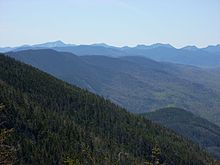| Taiga | |
|---|---|
 | |
 The taiga is found throughout the high northern latitudes, between the tundra and the temperate forest, from about 50°N to 70°N, but with considerable regional variation. | |
| Ecology | |
| Biome |
|
| Geography | |
| Countries |
|
| Climate type |
|
Taiga or tayga (/ˈtaɪɡə/ TY-gə; Russian: тайга́), also known as boreal forest or snow forest, is a biome characterized by coniferous forests consisting mostly of pines, spruces, and larches. The taiga or boreal forest is the world's largest land biome.[1] In North America, it covers most of inland Canada, Alaska, and parts of the northern contiguous United States.[2] In Eurasia, it covers most of Sweden, Finland, much of Russia from Karelia in the west to the Pacific Ocean (including much of Siberia), much of Norway and Estonia, some of the Scottish Highlands,[citation needed] some lowland/coastal areas of Iceland, and areas of northern Kazakhstan, northern Mongolia, and northern Japan (on the island of Hokkaidō).[3]

The principal tree species, depending on the length of the growing season and summer temperatures, vary across the world. The taiga of North America is mostly spruce; Scandinavian and Finnish taiga consists of a mix of spruce, pines and birch; Russian taiga has spruces, pines and larches depending on the region; and the Eastern Siberian taiga is a vast larch forest.[3]
Taiga in its current form is a relatively recent phenomenon, having only existed for the last 12,000 years since the beginning of the Holocene epoch, covering land that had been mammoth steppe or under the Scandinavian Ice Sheet in Eurasia and under the Laurentide Ice Sheet in North America during the Late Pleistocene.
Although at high elevations taiga grades into alpine tundra through Krummholz, it is not exclusively an alpine biome, and unlike subalpine forest, much of taiga is lowlands.
The term "taiga" is not used consistently by all cultures. In the English language, "boreal forest" is used in the United States and Canada in referring to more southerly regions, while "taiga" is used to describe the more northern, barren areas approaching the tree line and the tundra. Hoffman (1958) discusses the origin of this differential use in North America and how this differentiation distorts established Russian usage.[4]
Climate change is a threat to taiga,[5] and how the carbon dioxide absorbed or emitted[6] should be treated by carbon accounting is controversial.[7]

- ^ "Berkeley: The forest biome". Ucmp.berkeley.edu. Archived from the original on 2019-06-20. Retrieved 2019-05-12.
- ^ "List of Plants & Animals in the Canadian Wilderness". Trails.com. 2010-07-27. Archived from the original on 2018-09-14. Retrieved 2016-12-26.
- ^ a b "Taiga | Plants, Animals, Climate, Location, & Facts | Britannica". www.britannica.com. Retrieved 2023-05-04.
- ^ Hoffmann, Robert S. (1958). "The Meaning of the Word "Taiga"". Ecology. 39 (3): 540–541. Bibcode:1958Ecol...39..540H. doi:10.2307/1931768. JSTOR 1931768.
- ^ Graham, Karen (2021-05-19). "'Zombie fires' may become more common as the climate warms". Digital Journal. Retrieved 2021-06-04.
- ^ Phillips, Carly (Apr 27, 2022). "Carbon Emissions from Boreal Forest Wildfires". Union of Concerned Scientists. Retrieved 2022-05-31.
- ^ "How should the world's nations account for the carbon absorbed by their forests? We better figure it out". Bellona.org. 2021-05-18. Retrieved 2021-06-04.